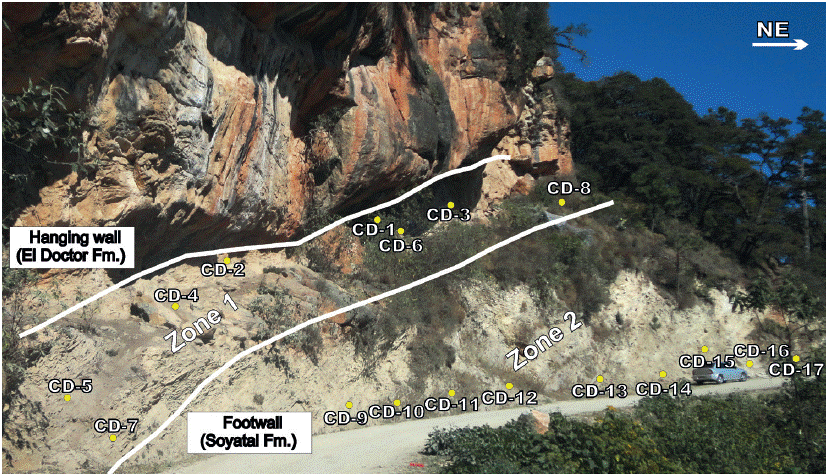INTRODUCTION
The occurrence of authigenic and synkinematic clay-mica minerals is a common feature in fault zones. Isotopic dating of these minerals has been used extensively in the last 20 years to assess the timing of faulting episodes and to reconstruct the tectonic evolution of mountain belts (Lyons and Snellenburg, 1971; Clauer et al., 1997; Vrolijk and van der Pluijm, 1999; Zwingmann and Mancktelow, 2004; Solum et al., 2005; Schleicher et al., 2006; van der Pluijm et al., 2006; Siebel et al., 2010; Zwingmann et al., 2010a, 2010b; Duvall et al., 2011; Surace et al., 2011; Verdel et al., 2011a, 2011b; Zwingmann et al., 2011; Tagami, 2012; Clauer, 2013; Viola et al., 2013; Middleton et al., 2014; Torgersen et al., 2015). The fundamental premise of isotopic dating of faults is that the formation of fault rocks is the result of various physical and chemical processes related to fluid circulation, pressure and temperature conditions during the deformation. Therefore, the understanding of thermal regimes of fault zones, together with detailed mineralogical and textural observations, is crucial for the thermochronologic interpretation of radiometric clay-mica ages. Although K-Ar dating of illitic clay fractions in fault zones has been used by many authors, the interpretation of these data is sometimes difficult because the different mechanisms of illite growth in faults are controversial (e.g. Środoń, 2002). The Mesozoic and Cenozoic geologic history of Mexico is characterized by an abundant record of orogenic events, but isotopic dating of fault related clay-mica minerals was only sparsely applied (e.g. Gray et al., 2001; Fitz-Díaz et al., 2014). This led to an incomplete reconstruction and understanding of the structural evolution of Mexico, which is the key to interpreting the tectonic history of North America.
In this paper, we present a combination of structural, petrographic, mineralogic and K-Ar isotopic data from the El Doctor thrust fault, which is considered a major structure of the Late Cretaceous-Paleogene Laramide orogen in Mexico (Suter, 1984, 1987). These data represent the first contribution to clay-mica dating of faults obtained at the Laboratories of the Instituto de Geología (Universidad Nacional Autónoma de México), and serve as a starting point for the development of such methodologies in Mexico. The results obtained will be integrated with previous data and will be interpreted in the framework of the Laramide orogenic evolution proposed by previous authors.
GEOLOGICAL SETTING
The Mexican Fold and Thrust Belt (MFTB) is a remarkable morphotectonic feature in the geology of Mexico because of its extent and prominent topographic expression in the Sierra Madre Oriental (Figure 1). This belt is interpreted as a dominantly thin-skinned Late Cretaceous-Early Paleogene orogenic wedge that formed by considerable horizontal shortening of the continental interior of Mexico (Suter, 1984, 1987; Fitz-Díaz, 2010; Fitz-Díaz et al., 2011). In the Peña de Bernal-Tamazunchale area, the MFTB displays an eastward-tapering wedge shape and a gradient in the deformation and temperature progressively decreasing to the east (Fitz-Díaz et al., 2011). According to the orogenic wedge models of Dahlen et al. (1984) and Dahlen (1990), these characteristics indicates that the "bulldozer" producing such a regional deformation should have been located to the west of the MFTB, and that shortening must have propagated progressively to the east. This is supported by paleontologic data, which indicates that the synorogenic deposits across the Peña de Bernal-Tamazunchale section are progressively younger to the east (López-Ramos, 1983; Hernández-Jáuregui, 1997).
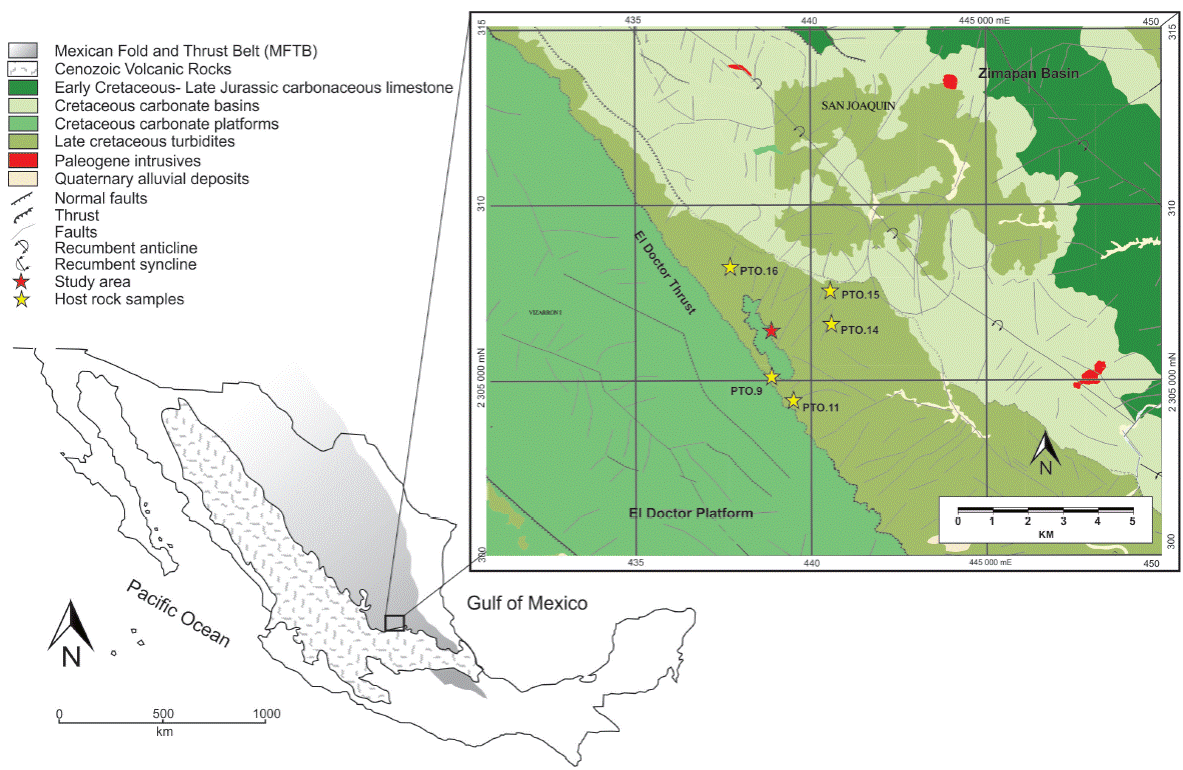
Figure 1 Schematic geological map showing the location of the study area, the extension of the Mexican Fold and Thrust Belt (MFTB) and the Cenozoic volcanic rocks. Modified from Martini et al. (2012).
At least, two different shortening phases have been documented in the MFTB (Fitz-Díaz et al., 2012). D1 is considered as the main tectonic event that built up the Sierra Madre Oriental and is expressed by kilometer-scale, T1 thrusts and F1 folds that accommodated several hundred kilometers of shortening (Suter, 1980, 1984, 1987; Ortega-Flores, 2010; Fitz-Díaz et al., 2012). Based on stratigraphic constraints, this deformation event took place between the Turonian and Santonian periods in the western MFTB, and between the Campanian and Maastrichtian periods in its eastern part (Hernández-Jáuregui, 1997). D2 is expressed only by gentle F2 folds and meter-scale displacements on late T2 thrust faults superposed to D1 structures (Ortega-Flores, 2010; Fitz-Díaz et al., 2012). F2 folds and T2 faults affected LateCretaceous deposits, which provide a temporal limit to this second deformation event (Fitz-Díaz et al., 2014). D1 and D2 are interpreted by Fitz-Díaz et al. (2011) as the result of the Sevier and Laramide orogenies, respectively. According to this scenario, the MFTB is the product of a complex Late Cretaceous-Early Paleogene structural evolution which resulted from the superposition of at least two different orogenic pulses. Finally, the MFTB is cut by high-angle post Eocene normal and oblique faults that produced a complex horst and graben structural pattern. The El Doctor thrust fault is exposed in the western part of the Peña de Bernal-Tamazunchale section (Figure 1). This structure was described as a northeast-southwest (NE-SW) trending, moderately SW dipping, brittle-ductile T1 shear zone which produced the top-to-the-NE overriding of Aptian-Albian platform limestones of the El Doctor Formation onto Turonian-Lower Santonian (Omaña Pulido, 2012) calcareous turbidites of the Soyatal Formation, which were interpreted as the syntectonic deposits related to the D1 orogenic event (Suter, 1987). Considering that this shear zone is a major structure representative for the evolution of western MFTB, we took an exposure of the El Doctor thrust to test the potential of illite-mica in dating lowintermediate grade faults, as well as for improving the reconstruction of the Late Cretaceous-Early Paleogene structural evolution in central Mexico. The outcrop selected for this study is located to the west of Querétaro, Mexico (Figure 1).
METHODOLOGY
Sampling and sample preparation
Structural data of the fault zone and surrounding outcrops were collected during the fieldwork. These comprise fault, foliation and axial plane surfaces, fold axes, and lineations. Oriented samples were collected and cut parallel to the XZ plane of the finite strain ellipsoid, in order to determine the kinematics of the main structures and the mineral phases which compose the foliation surfaces.
A total of 17 unweathered lutite samples of 200-500 g were collected for clay characterization from a 30 m long traverse across the Soyatal Formation, which is exposed in the footwall of the El Doctor thrust fault (Figures 1 and 2). The hanging wall of the fault was not sampled because lutite strata are practically absent in the El Doctor Formation. Eight samples were collected from the core of the main fault zone, which is designated in this work as Zone 1. This zone extends from the tectonic contact between the El Doctor and Soyatal Formations to ~5 m depth into the footwall. Nine samples are from less pervasively deformed rocks of the outer part of the fault zone, which is designated in this work as Zone 2. This zone is ~25 m thick and extends downward from the lower boundary of Zone 1 to the last strata displaying clear evidence of deformation related to the T1 El Doctor thrust fault. Four host rock samples (Figure 1) were also collected to determine their mineralogy and to ascertain the presence of detrital or diagenetic illite and mica.
Samples were prepared following standard X-ray diffraction (XRD) procedures (Moore and Reynolds, 1997) and the recommendations by the IGCP 294 IC working group (Kisch, 1990). Sample sizes of 50-100 g for each lutite sample were used for clay separation. Samples were gently disaggregated to avoid artificial grain size reduction of rock components (Liewig et al., 1987). Each sample was broken into small chips (2 mm) using a porcelain crusher and subsequently dispersed in deionized water. For clay separation, we used the most unaggressive method (Jackson, 1985; Moore and Reynolds, 1997). Grain size fractions of <2 μm and 2-4 μm were separated in distilled water according to Stoke's law. A portion of the <2 μm fraction obtained by sedimentation was centrifuged in order to extract the coarse (2-0.5 μm), medium (0.5-0.05 μm) and fine (<0.05 μm) clay fractions. Coarsegrained fractions (2-4 μm) were investigated in three samples from the fault and four samples from the host rock, far away from the fault, to evaluate the influence of potential contamination from detrital or diagenetic protolith minerals.
From the <2 μm fractions, air-dried oriented preparations were obtained by pipetting some drops of the Mg-saturated suspensions onto a glass slide, which was then dried at 30 °C for a few hours (Moore and Reynolds, 1997). Ethyleneglycol solvation of the slides was achieved by exposing them to ethyleneglycol vapor at 70 °C for a minimum of 12 hours. Randomly oriented samples were prepared by packing 150-250 mg of dried material as small clay spheres which were cut and mounted in low background sample holders.
X-ray diffraction
The mineralogy of the different size fractions was determined by XRD. Measurements were made using a Shimadzu XRD-6000 diffractometer at the Instituto de Geología, of the Universidad Nacional Autónoma de México (UNAM), operating with an accelerating voltage of 40 kV and a filament current of 30 mA, using CuKα radiation and a graphite monochromator. Non-oriented samples from each whole rock were measured over a 2θ angular range of 4-70 ° at a speed of 1 °(2θ).min-1.
Oriented clay samples were examined by XRD in the air-dried form, after saturation with ethyleneglycol and after heating at 450 °C and 550 °C. All preparations were measured over a 2θ range of 4-70 ° (air-dried) and 4-40 o (glycolated and heated) at a speed of 1 °(2θ).min-1. Glycolated XRD analyses were carried out to investigate potential occurrence of expandable mixed layer smectite minerals (Moore and Reynolds, 1997). Identification and analysis of clay minerals by XRD has been described by Brindley and Brown (1980) and Moore and Reynolds (1997).
The Kübler index (KI), a measure of illite 'crystallinity', was measured using the full width at half maximum (FWHM) of the 10 Å illite peak on oriented clay preparations from the <2 μm fraction (Kübler, 1967, 1968; Kübler and Jaboyedoff, 2000) and expressing the results in terms of the Bragg angle 2θ. We use the term 'illite-mica' when it is not possible to distinguish between the two minerals by XRD (KI near 0.25) and includes illite and clay-sized muscovite.
Identification of illite and evaluation of the percentage of expandable layers in mixed illite/smectite were made using the methods described by Środoń (1984), Środoń and Eberl (1984), Reynolds (1992) and Moore and Reynolds (1997).
Illite polytype quantification was made by comparison between the diffractograms for randomly oriented samples of different fractions and simulated patterns calculated using WILDFIRE software (Reynolds 1993, 1994), adjusting the effects of preferred orientation. The WILDFIRE patterns are calculated considering a mixture of 1M polytype (60 % cv, P0=1 and P60 =0) with 2M1 polytype (Drits et al., 1995; Drits et al., 1998) in different proportions. Polytype quantification was calculated only for the coarse and total fractions of samples dated by K-Ar. There was not enough material available from smaller fractions to run the appropriate measurements.
For polytype identification, intensities were recorded at 0.04 °2θ step intervals from 10 to 40 °, using 40 seconds counting time per step. Sizes of the divergence slit, anti-scatter and receiving slits were 1°, 1°, and 0.15 mm, respectively.
The percentage of 2M1 illite-mica relative to 1M illite was determined from the ratio I(2.80Å)/I(2.58Å) (Maxwell and Hower, 1967) for all samples, and by comparison of high-resolution patterns from randomly oriented samples with calculated patterns using the WILDFIRE software (e.g., Grathoff and Moore, 1996; Ylagan et al., 2000, 2002).
Semi-quantification of clays by X-ray diffraction
The proportion of clay species was estimated semi-quantitatively from oriented preparations using simple peak weighting factors. For area estimation we used the Fityk software for nonlinear curve fitting (Wojdyr, 2010). The glycolated XRD trace was separated into illite, smectite and mixed-layer peak areas by calculation of the percentage of these areas (Moore and Reynolds, 1997; Środoń et al., 2001).
Peak decomposition
A mathematical decomposition procedure has been systematically applied to air-dried patterns in the 6 ° to 13 °2θ region (Lanson and Besson, 1992; Lanson, 1997) using the Fityk peak fitting software (Wojdyr, 2010). The first step of the procedure was the subtraction of the background from the pattern. The second step was the calculation of curves which fit the experimental diffractogram using the least-squares method. We used two curves for the decomposition of the air-dried samples. The 10.1-10.5 Å peak (Gaussian curve) is the 001 reflection of a poorly crystallized illite (PCI). The sharper peak (Gaussian curve), closer to 10 Å, corresponds to particles having a large crystallite size such as mica or a well crystallized illite (WCI).
Electron microscopy
Some samples have been imaged by scanning electron microscopy (SEM) to observe the actual morphology of mica and illite. Freshly broken rock surfaces of rock chips were cleaned in an ultrasonic bath, gold coated and examined in mixed secondary and backscattered electron mode using the MEB Nova-2000 NANOLAB scanning electron microscope at the Instituto Mexicano del Petróleo. The SEM was operated at 30 kV and a current less than 20 nA, and equipped with an energy dispersive X-ray analyzer (EDS-Genesis 4000). In general, illite clusters are characterized by a dense meshwork of platy clay minerals and a minor proportion of fine-grained authigenic fibrous clay material.
K-Ar dating
Dating of clay fractions was performed using the K-Ar dating method. The methodology used is a modification of the classical technique, specifically designed to date small amounts of sample. For potassium (K) analysis we use X-ray fluorescence with high dilution fused pearls to minimize both the amount of sample (50-100 mg) and the matrix effects (Solé and Enrique, 2001). For argon (Ar) quantification, a CO2 laser system is used for sample fusion, followed by gas cleaning and measurement in a MM1200B noble gas mass spectrometer at Instituto de Geología, UNAM. This technique is able to measure samples in the milligram range and is described in detail by Solé (2009).
RESULTS
Structural and petrographic observations
The detailed structural analysis of the El Doctor fault zone allows the identification of at least four superposed groups of structures, which we identify as D1 to D4. The D1 group is represented by the El Doctor thrust fault, a brittle-ductile shear zone which produced the overriding of Aptian-Albian platform limestone of the El Doctor Formation onto the Turonian-Santonian synorogenic turbidites of the Soyatal Formation. Such a T1 shear zone is associated with a NW-SE striking, SW dipping S1 foliation parallel to the S0 bedding planes (Figure 3a). S1 is pervasive at the submillimeter scale in Zone 1, which is the core of the shear zone, and progressively becomes less penetrative at the shear zone boundaries. In lutites of the Soyatal Fomation, S1 is a slate cleavage defined by aligned phyllosilicates, finegrained slaty minerals and oxides (Figures 3b and 3c). Phyllosilicate content decreases progressively from the core to the boundary of the shear zone, suggesting the occurrence of a temperature gradient normal to the fault surface. In sandstones of the Soyatal Formation, S1 varies from a spaced, disjunctive, smooth foliation to anastomozing foliation. Cleavage domains consist primarily of fine-grained seams of opaque minerals, whereas microlithon domains are composed of recrystallized calcite and scarce lowto moderately-elongated quartz grains with pressure shadows, undulose extinction, and locally subgrain domains. In platform limestone of the El Doctor Formation, S1 is a spaced, smooth to stylolithic foliation defined by fine-grained opaque minerals. Such microtextural evidence suggests that S1 was formed mostly by pressure-solution processes and minor crystal plastic deformation, which indicates that structures of the D1 group were formed at temperatures <400 °C (e.g. Passchier and Trouw, 1998). This is also supported by the syntectonic crystallization of phyllosilicates and slaty minerals, which suggests a low greenschists or subgreenschists metamorphic grade. Scarce S-C microstructures and asymmetric porphyroclasts observed on cuts parallel to the XZ-plane of the finite strain ellipsoid indicate a top-to-the-NE tectonic transport for the El Doctor thrust (Figures 4a and 4b), which is in agreement with the kinematics reported by previous authors.
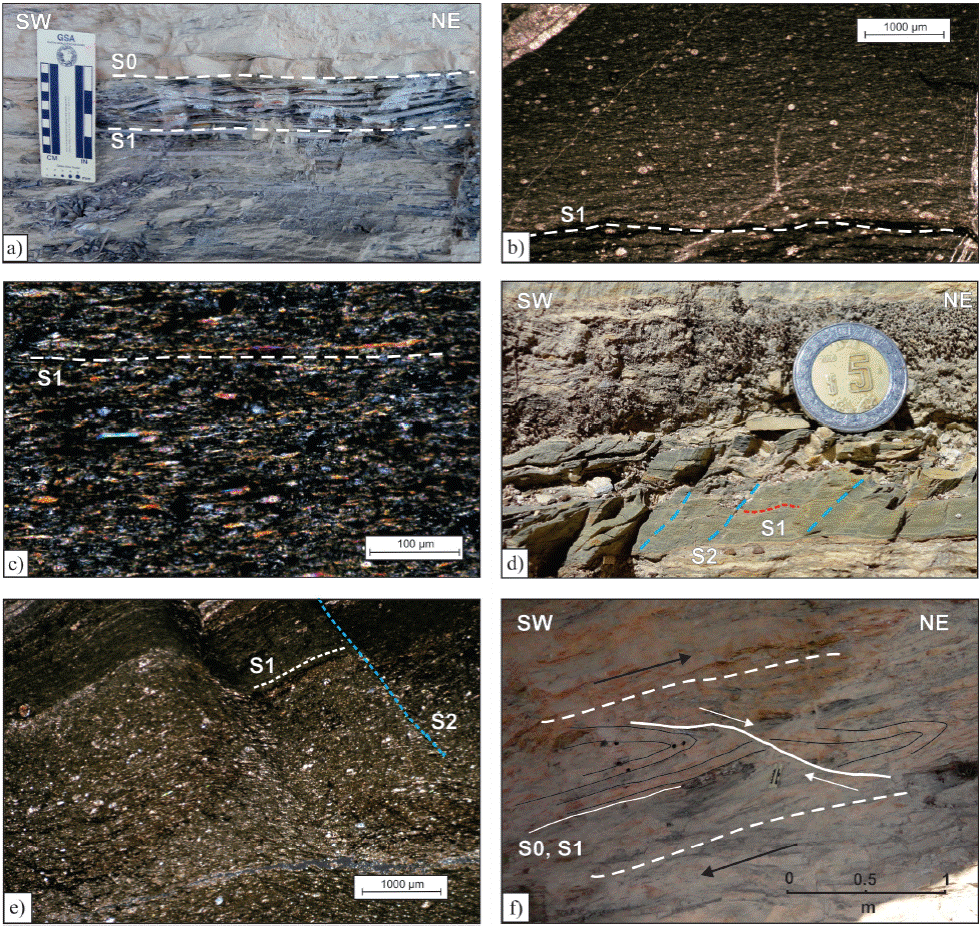
Figure 3 (a) S1 foliation parallel to the S0 bedding planes, S1 is pervasive at the submillimeter-scale. (b) Smooth to anastomozing foliation defined by oxides; main deformation mechanism: pressure solution (calcite). (c) S1 foliation defined by fine-grained phyllosilicates; main deformation mechanism: pressure solution and crystallization (phyllosilicates). (d) and (e) S2 foliation is pervasive at the submillimeter-scale, S2 is a spaced crenulation cleavage superposed on S1, and defined only by fine-grained seams of opaque minerals. (f) F2 folds are cut by meter-scale, NW-SE striking, NE gently dipping extensional shear (green line).
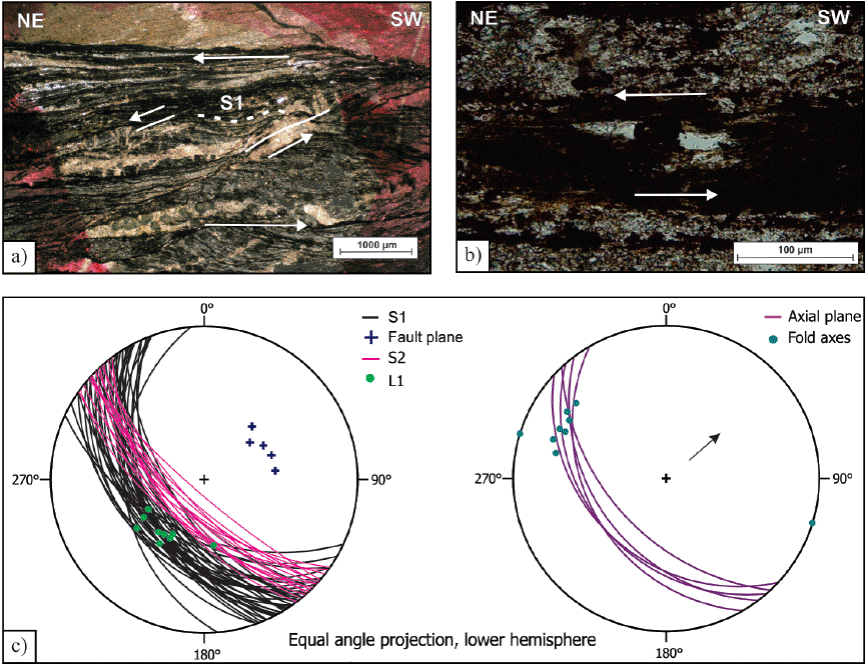
Figure 4 (a) S-C' microstructures observed on cuts parallel to the XZ-plane of the finite strain ellipsoid. (b) Asymmetric porphyroclasts observed on cuts parallel to the XZ-plane of the finite strain ellipsoid indicate a top-to-the-NE tectonic transport for the El Doctor thrust. (c) Equal angle, lower hemisphere projections of great circles to S1, S2 and poles to L1 thrust-related lineations. Fold axes and axial plane are also plotted in the stereographic nets, showing a top-to-the-NE tectonic transport.
Structures of the D2 group are represented by meter-scale, NEoverturning, tight F2 folds that developed exclusively in the Soyatal Formation, either in Zone 1 or in Zone 2. The F2 folds display NW-SE striking, NW gently plunging axis, and are associated with an S2 axial plane foliation which is evident only in lutite layers. S2 is a spaced crenulation cleavage superposed on S1, and is defined only by finegrained seams of opaque minerals (Figures 3d and 3e).
The F2 folds are cut by meter-scale, NW-SE striking, gently NE dipping extensional shear bends that were observed exclusively in the Zone 1 turbidites from the Soyatal Formation (Figure 3f).
Finally, high-angle normal faults cut pre-existing D1-3 structures and are associated with centimeter to decimeter-thick gouge and cataclasite.
Whole-rock mineralogy
All analyzed samples were collected from the Soyatal Formation, since it is the only unit containing shale strata at the study outcrop.
The whole-rock mineralogy comprises quartz, calcite, minor plagioclase, feldspar, illite-mica, smectite, kaolinite, vermiculite and traces of chlorite, which are present in variable proportions. XRD analyses of all the samples are summarized in Table 1.
Table 1 Whole rock mineralogy.
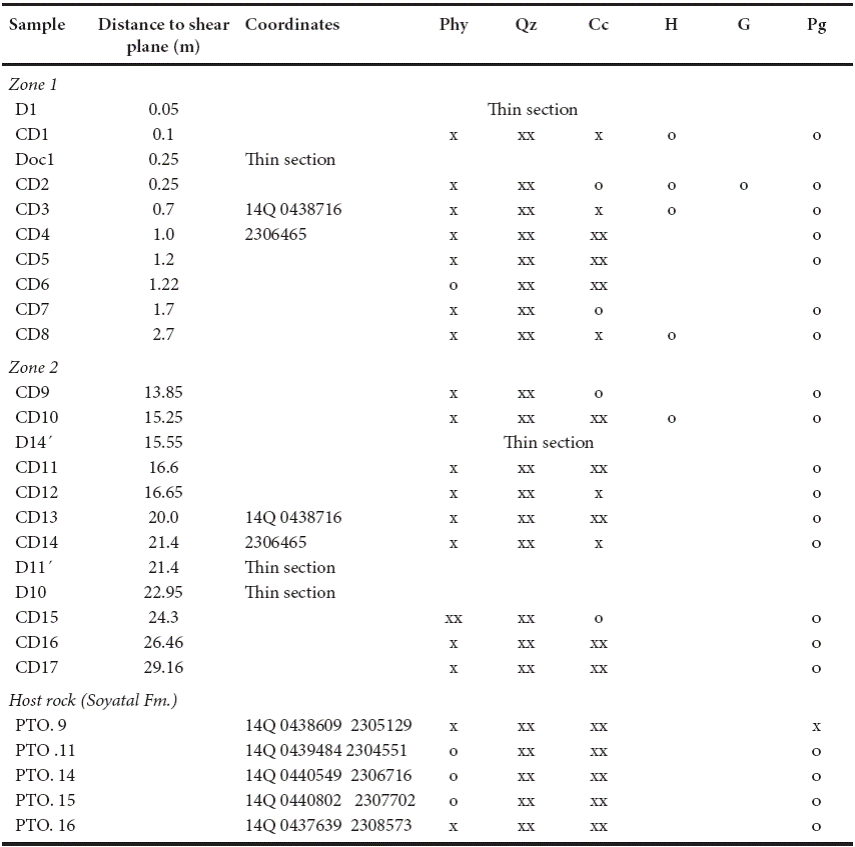
Phy: phyllosilicates. Qz: quartz. Cc: calcite. H: hematite. G: goethite. Pg: plagioclase. xx: >25%. x: 10-25%. o: <10%.
The host rock mineralogy is not uniform and all outcrops show evidences of deformation. The four analyzed samples confirm the presence of quartz, calcite, minor plagioclase and phyllosilicates in the whole-rock (Figure 5). Using separated clay fractions from host rocks, illite-mica (KI <0.25 in coarse fractions), kaolinite and chlorite were identified in variable proportions. Minor smectite or vermiculite was also detected by XRD.
Mineralogy of clay subfractions
All subfractions display a clay assemblage consisting of illite-mica with scarce kaolinite in Zone 1, changing into a illite-mica, smectite, vermiculite and traces of chlorite paragenesis in Zone 2 (Table 2). Illitemica is the major clay mineral component and the unique K-bearing phase of all clay subfractions.
Table 2 Clay fraction mineralogy.
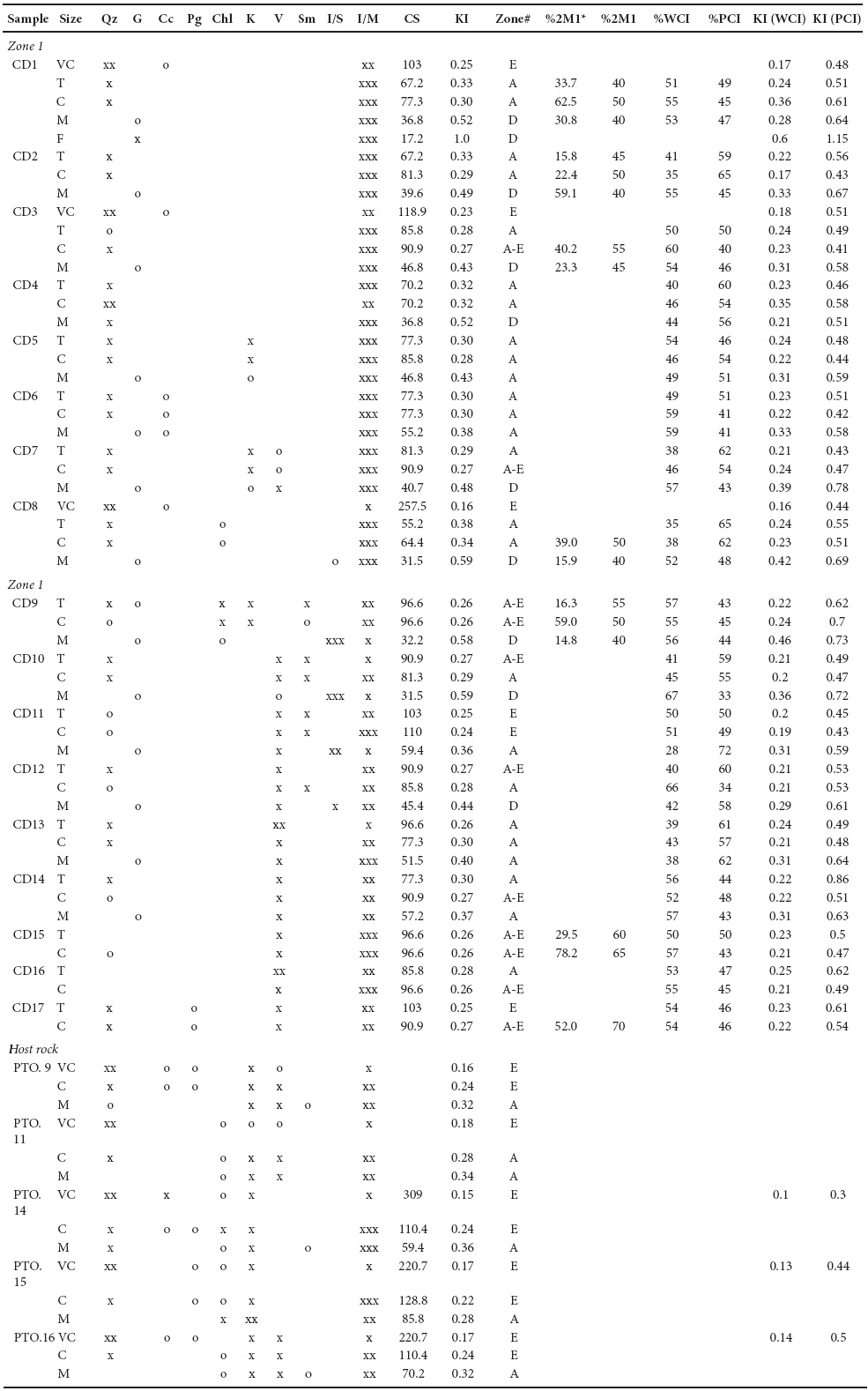
xxx = >65 %, xx = 65-45 %, x = 45-10 %, o = <10 %.T: <2 μm total fraction. VC: very coarse (4-2 μm). C: coarse fraction (2-0.5 μm). M: medium fraction (0.5-0.05 μm). F: fine fraction (< 0.05 μm). Qz: quartz. Cc: calcite. Pg: plagioclase. Chl: chlorite. K: kaolinite. V: vermiculite. Sm: smectite. I/S: illite/smectite. I/M: illite-mica. CS: crystallite size. KI: Kübler Index. WCI: well crystallized illite. PCI: poorly crystallized illite. #: Metamorphic grade. D: Diagenesis. A: Anchizone. E: Epizone. %2M1*: illite polytype quantifications using the equation [I (2.80 Å) / I (2.58 Å)]. %2M1: illite polytype quantifications using WILDFIRE.
Pure smectite and mixed-layer minerals were identified only in the coarse and medium fractions, respectively, of four samples from Zone 2. Considering the subgreenschist metamorphic grade of the shear zone we infer that smectite minerals postdate the main fault movement.
Illite Kübler index (KI) and crystallite size (CS) were calculated (shown in Table 2) and used for the evaluation of the kinematic history of phyllosilicate-bearing rocks assuming anchizone limits of 0.25 ° 2θ and 0.42 ° 2θ KI index (Kübler, 1968; Kisch, 1991).
Illite from Zone 1 samples contains more than 95% of illite-mica in all coarse fractions. This suggests illite crystallization at temperatures higher than 250 °C (Abad, 2006), which is in good agreement with the temperature inferred for the subgreenschist metamorphic grade of the El Doctor shear zone. The individual KI values measured for samples from Zone 1 range from 0.26 for the coarse fractions to 0.58 for the medium fractions. Converted to the Kübler scale, these define a temperature range which varies from the epizone-anchizone limit to the diagenetic field (Kübler, 1968; Kisch, 1991). Crystallite size (CS) is between 32 and 97 nm for the medium and coarse fractions, respectively, of Zone 1. SEM images (Figure 6) reveal that illite crystallites in Zone 1 have a strong preferred orientation and exhibit platy morphologies, which suggest in situ neocrystallization. In synthesis, the detailed sample characterization presented in this work supports the authigenic origin of illite-mica for samples from Zone 1.

Figure 6 Electron microscopy (SEM) images of illite from the El Doctor fault. Image (a) illustrates the typical sample surface within, a 10 μm overview, made of coarse authigenic illite with predominantly platy habit from sample CD1. The size of the authigenic minerals can be related to the lower greenschist facies reached during the main deformation and crystallization event. Note that the coarse illite flakes delineate the foliation, an indication of authigenic origin. Illite mineral species was confirmed by EDS analysis. Images (b), (c) and (d) illustrate authigenic filamentous and lath illite from the finest fraction, which represents the last illite grown in the fault rock. Authigenic illite fibers growth from platy particles [(d) and (f)] and can extend up to several μm. In image (e), the sub-μm rosettes growing on the illite are secondary iron oxides (hematite). SEM image evidences the growing of these crystals by processes of dissolution-precipitation associated with faulting.
The KI values for different size fractions of Zone 2 range from 0.24 to 0.59, whereas the CS is between 31 and 110 nm for the medium and coarse fractions, respectively. KI values for <2 μm illite in Zone 2 are similar to the values obtained for Zone 1. Only for >2 μm fractions of Zone 2, the KI values are smaller than in Zone 1, which suggests the influence of detrital phases in these >2 μm fractions. The presence of smectite and vermiculite is interpreted as late low-temperature transformation.
Clay polytype characterization
For the studied samples, the amount of 2M1 ranges from 40-55% in both Zone 1 and Zone 2, except for three samples of Zone 2 which have 60 to 70%. This variation is related to size fraction, and all the finest fractions are richer in 1M polytype than the coarsest fractions. The high-temperature authigenic illite (2M1) from the El Doctor shear zone cannot be distinguished from detrital muscovite (2M1). Considering the presence of illite-mica foliation (T>300 °C; Passchier and Trouw, 1998) we interpret that detrital mica might be present only in the very coarse fractions (>2 μm). In this sense, the quantification of illite polytypes cannot be used to measure the relative proportions of detrital and authigenic illite from the El Doctor shear zone.
Decomposition of the illite 001 XRD peak (Figure 7a) from oriented preparations also indicates mixtures of two illites (Meunier and Velde, 2004; Meunier et al., 2004). The differentiation and quantification between poor crystallized illite (PCI) and well crystallized illite (WCI) is a convenient way to describe the illite population. The presence of PCI influences the global peak position (shift towards lower angle) and peak FWHM (peak broadening). The relative abundance of the PCI peak is expressed as a percentage. Decomposed peak positions are expressed in Å, whereas FWHM are expressed in 2θ CuKα (Table 2). The percentage of PCI accounts for the relative proportion of illite crystallites with lower crystallite size.
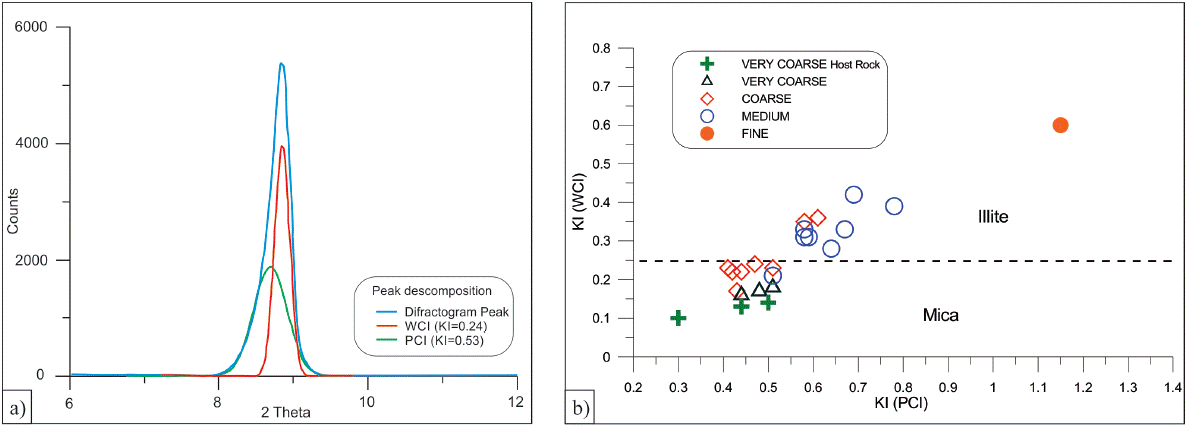
Figure 7 (a) Example of illite 001 peak decomposition using the Fityk 0.9.3 software (Wojdyr, 2010). (b) Correlation of KI of WCI and KI of PCI for different clay fractions. WCI = well crystallized illite, PCI = poorly crystallized illite.
Proportions of WCI range from 35 to 67%. In general, high abundances of WCI are associated with the coarse fractions and low abundances are associated with the finest fractions. Peak decomposition values give similar percentages of WCI to those derived from the analysis of the random powder data using the WILDFIRE software (Table 2) for 2M1. The peak widths of PCI and WCI diminish together (Figure 7b), indicating that there is a simultaneous growth of both components in different size fractions.
K-Ar data
We dated 31 clay fractions from 12 samples, seven from the fault zone and five from the host rock. K-Ar analyses of <0.5 to 4 μm fractions separated from different samples yielded ages ranging from 97.9 ± 1.6 Ma to 39.1 ± 0.8 Ma (1σ)(Figure 8 and Table 3). Radiogenic40 Ar ranges from 88 to 99% indicating small to very small atmospheric contamination. All <2 μm clay fractions from the fault zone are younger than the Lower Santonian (86 Ma), the paleontological age of the upper part of the Soyatal Formation (Omaña Pulido, 2012).
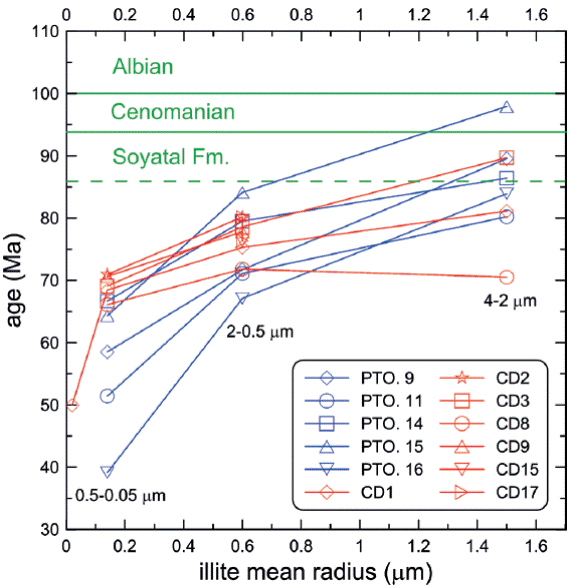
Figure 8 Summary of K-Ar ages plotted against mean radius of illite fractions from the study area. CD samples are from the fault zone and PTO samples are from the Soyatal Formation far from the El Doctor fault. The stratigraphic age of the Soyatal Formation is also displayed. CD8 has been sampled on a later shear, showing the youngest age from very coarse fractions. The significance of this age (~70 Ma) is uncertain, but can represent the true age of the movement of the secondary fault (see text).
Table 3 K-Ar ages from illite fractions from the El Doctor fault (CD samples) and the Soyatal Formation (PTO samples).
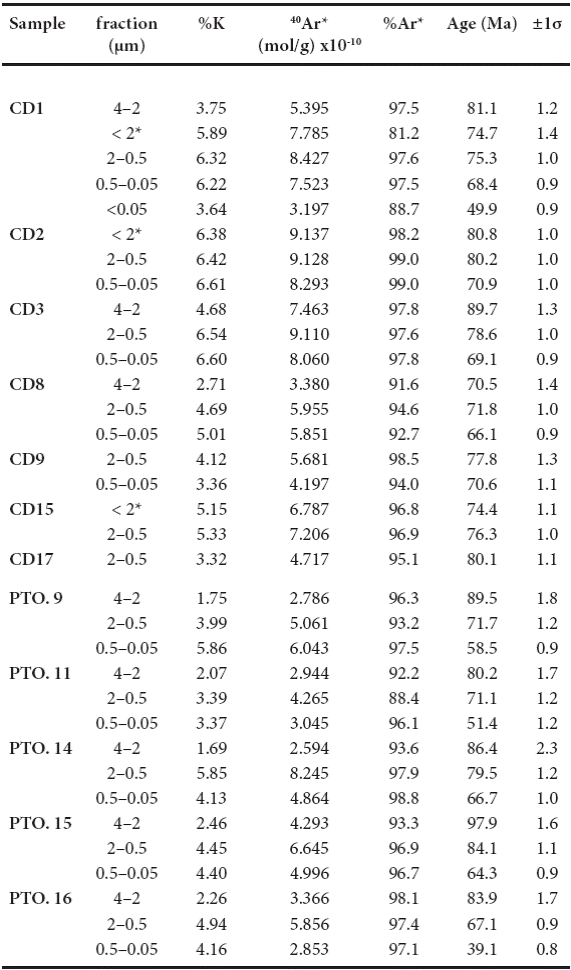
* Total clay fraction < 2 μm
K-Ar ages become younger with increasing KI and the smaller size fractions are the youngest. The K-Ar ages for the fault zone (CD samples) from very coarse (4-2 μm) illite fractions range between 90 and 81 Ma (70 Ma for the CD8 sample that has been affected by a later shear bend, Figure 3f). For coarse (2-0.5 μm) illite fractions the K-Ar ages range between 80 and 72 Ma. For medium (0.5-0.05 μm) and fine grained (<0.05 μm) illite fractions, the K-Ar ages range between 71 Ma and 66 Ma, and 50 Ma, respectively. Ages from the host rock (PTO samples) show a range of 98 to 80 Ma for the very coarse (2-4 μm) illite fraction, a range of 84 to 72 Ma for the coarse (2-0.5 μm) illite fraction, a range of 67 to 59 Ma for the medium (0.5-0.05 μm) illite fraction, and an age of 40 Ma for a <0.05 μm fraction. The host rock display ages that are equal or older than the stratigraphic age of the Soyatal Formation for the 4-2 μm fractions and smaller fractions show higher age dispersion than the samples from the fault (Figure 8).
DISCUSSION
Dating of diagenesis and faults
The use of the K-Ar dating of clay minerals to decipher the history of a sedimentary rock is an old methodology dating back to the first decade of the K-Ar technique (Hurley et al., 1959). It has been quickly recognized that K-Ar ages of such samples do not give the correct age of the sediment. The ages were either too old or too young. Bailey et al. (1962) measured for the first time the polytypes 2M1 and 1Md using the K-Ar method on samples from the Pennsylvanian shale. The 2M1 polytype was much older than the stratigraphic age, and the 1Md was much younger. From these pioneering works up to the present, considerable effort has been made in the interpretation of the K-Ar age of clay minerals, mainly illite.
The dating of tectonic processes using clays is even more complex. Not having, in most cases, alternative approaches to the K-Ar or Ar-Ar methods (and Rb-Sr in some cases), we must date grain-size fractions of some samples taken from both the fault zone and the host rock, the latter far away from the influence of the fault. The basic reason for doing so is that the development of authigenic clays in a fault zone is a convolution of two processes: recrystallization and growth due to burial (diagenesis s.s.) and recrystallization and growth due to strain (tectonics s.s.). Complete deconvolution of the two processes is difficult. If the ages are older than the minimum stratigraphic age, then illite is mainly detrital and no more information can be obtained (except for provenance studies). If the ages are younger than the stratigraphic age, three cases can be envisaged: (1) illite is neoformed, (2) illite has lost a fraction of its initial argon, or (3) illite is a mixture of both neoformed and detrital types.
The interpretation of geochronological data from faults has been somewhat controversial, due to the complexity of the problem caused mainly, but not exclusively, by the small grain size of clay minerals that impedes true mechanical separation of the different phases (e.g. detrital illite, authigenic illite). Thus, the actual interpretation of data is dependent on the methodology used. Systematic attempts to date fault movement by the use of K-Ar or Ar-Ar geochronometers date from the 1990s (e.g. Hamilton et al.,1992; Clauer and Chaudhuri, 1995) but was accentuated after the work of van der Pluijm et al. (2001). Two schools of thought emerged, one based on the use of the classical K-Ar method, and other on the use of the Ar-Ar method. The latter was championed by the publication of the 2M1-1M illite age analysis (Hunziker et al., 1986; Pevear, 1999) and the 'retention age' approach (Dong et al., 1995). In the last few years the controversy was accentuated by the finding that the illite age approach was not useful in many cases (e.g. Zwingmann et al., 2010a) and also because the 'retention age' interpretation has been discredited by one of the authors who proposed the original idea (Middleton et al., 2014). Some K-Ar versus Ar-Ar age arguments have also been published (Clauer, 2013) with no clear conclusion for either methodology. Torgersen et al. (2015) made a detailed study of a fault in Norway and proposed a conceptual model which is a synthesis of previous ideas applied to reactivated faults. In our opinion the model lacks the convolution of diagenesis described above, but is a good starting point to interpret complex faults.
Closure temperature of illite
The closure temperature (Dodson, 1973) of illite for the K-Ar geochronometer has never been determined experimentally. Nevertheless, an approximate number is necessary for data interpretation. To solve this unknown, two different values can be used: (1) the empirical temperature of 260 °C for the argon closure of an illite of ~2 μm grain size (Hunziker et al., 1986); or (2) the use of muscovite diffusion parameters (Harrison et al., 2009). In Table 4 we show the closure temperature calculated for muscovite of different grain sizes and we can see that the closure temperature for muscovite of relevant grain size is ~300 °C. This value represents the maximum closure temperature of illite, because the muscovite structure is the most stable member of the series smectite-illite-muscovite. In other words, experimental and empirical data suggests a closure temperature lower than ~300 °C for a clay-size illite.
Table 4 Closure temperature (°C) calculated for different grain sizes of muscovite following the model of Dodson (1973) and the diffusion parameters of Harrison et al. (2009).

* crystal radius; # Rate of cooling (in degrees Celsius per million years).
Temperature of the El Doctor fault and regional rocks
As discussed before, the temperature of the fault zone can be indirectly derived from the observed microstructure. The presence of foliation formed up by illite-mica (Figures 4, 6a) indicates a temperature of formation higher than 300 °C (Passchier and Trouw, 1998), in the structural zone shown in Figure 9. Regional host rocks from the El Soyatal Formation are also affected by some tectonic deformation even at several kilometers from the fault, so it is difficult (or even impossible) to find undeformed host rocks. This implies that the overall tectonic pile has been affected by the orogeny, an important point which is discussed later. In any case, the temperature at the fault zone was high enough to reset the K-Ar system of detrital micas, if present, of 2 μm of diameter or smaller, i.e. the clay fraction of the rock.
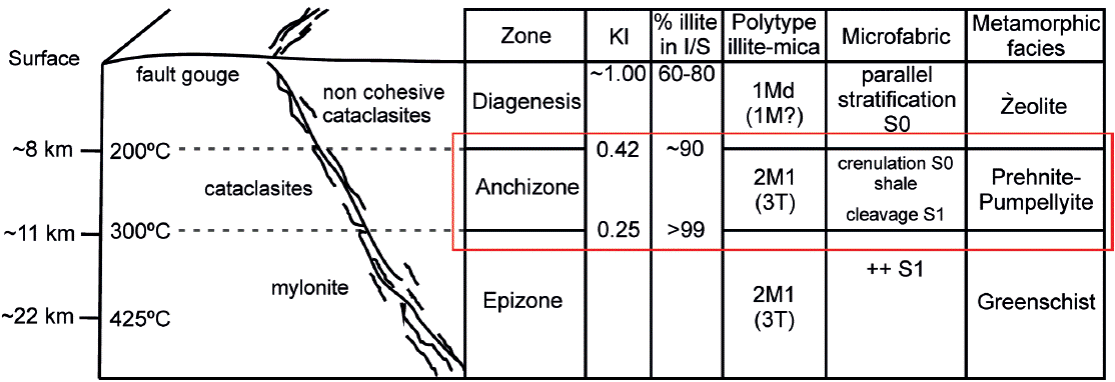
Figure 9 Synoptic model of a suture zone from Scholz (1988) and Abad (2006), showing the schematic section across the fault zone, along with illite parameters compared with temperature or depth. The red box shows the deformation conditions of the El Doctor Fault. KI: Kübler Index, % illite in I/S: percentage of illite in illite-smectite mixed-layered clays.
There is very little data about the regional temperatures reached by the Soyatal or other adjacent formations. The temperatures reported by Gray et al. (2001) in secondary fluid inclusions in microfractures in the footwall rocks of El Doctor fault thrust (Figure 1), range between 245 and 250 °C and are considered as a thermal anomaly centered at the frontal edge of the fold belt near the El Doctor fault zone. This temperature window is critical for illite-mica Ar loss (e.g., Merriman and Peacor, 1999) and because it is based on only a few analyses it may be interpreted as a minimum range for the burial temperature, to be related to the 'Laramide' orogeny (Gray et al., 2001).
Mineralogy from the El Doctor fault zone and the Soyatal host rock
To interpret the results one important condition must be fulfilled; that illite-mica is the only K-bearing phase in the system. This condition has been asserted by X-ray diffraction: no other K-bearing phases were present in the <4 μm fractions analyzed. In the case of the El Doctor fault zone the hanging wall is a carbonate from the El Doctor Formation and the footwall is the detrital Soyatal Formation. Due to the monomineralic nature of the carbonate, the samples used for K-Ar dating have been taken exclusively from the Soyatal Formation. One group was taken from the fault zone and another from the host rock (Figure 1 and Table 1). The large amount of phyllosilicates in the fault, when compared to the host rocks far from the fault, indicates synkinematic mineral growth, as deduced already by the petrographic and XRD studies.
XRD data illustrates that the micas from the fault zone have a relatively large range of KI, from 0.24 to 0.59, for the different illite fractions. The WCI and PCI peaks, obtained by decomposition of each illite fraction (Table 2), give a range of KI from 0.17 to 0.46 and from 0.41 to 0.86, respectively. In the PCI versus WCI plot (Figure 7) we can see that both parameters are correlated, which is an indication of simultaneous growth (Meunier and Velde, 2004). Texturally (shown in Figure 6) we can see that fibrous illite (1M) grows after platy illite (2M1), probably by dissolution. This fact is significant because no diagenetic or metamorphic process able to form a WCI from PCI must have occurred after the main fault phase because all illite-mica would have been WCI. In other words, all PCI observed today has been formed after WCI in susequent secondary orogenic movements or diagenesis.
Because the formation of WCI is more dependent on time than on temperature, geological processes which do not have enough time or temperature to convert all neoformed illite to the WCI component, will develop an important proportion of PCI. The dynamic process of illite formation in shales (Soyatal Formation), is governed by dissolutionrecrystallization of older minerals. The original radiogenic argon is lost from detrital micas (< 2 μm) which recrystallized. The growth of neoformed illite-mica during prograde metamorphism associated with faulting most likely occurs at the expenses of pre-existing detrital mica grains following the process of dissolution/precipitation (e.g., Inoue et al., 1988; Jaboyedoff and Cosca, 1999). In the El Doctor fault, this process is evidenced in the petrographic study. After the main fault event, a retrogression of the neoformed illite-mica minerals occurred, with the consequent generation of 1M illite (Figure 6). Analysis of shapes and crystal size distribution (Eberl et al., 1999) is important to interpret the growing process during illitization. Hairy illites are formed in short periods of time and perfect platy hexagonal crystals grow slowly. Platy subhedral habits and a strong preferred orientation demonstrate an authigenic origin.
K-Ar ages of all analyzed fractions
K-Ar ages (Table 3) are plotted in Figure 9. All data obtained from the <2 μm fractions at the fault are younger than the Middle TuronianLower Santonian age of the Soyatal Formation (Omaña Pulido, 2012), i.e. 94-86 Ma (ICS, 2014). This is a confirmation that detrital mica age has been reset during the heating of host rocks by frictional fault motions at the fault (e.g., Jaboyedoff and Cosca, 1999; Tagami, 2012). Moreover, the age of whole < 2 μm fractions (Table 3) is very similar to the age of the coarse (2-0.5 μm) fraction, indicating that this size fraction is the most important volumetrically in every sample. This fact is seldom discussed in the literature, but it is usual to find, during the grain size separation of clays, that the percentage of samples diminishes largely with the grain size. The finest illite (<0.05 μm) is present in very small amounts, and in many cases is even impossible to extract.
Using the data from Figure 9 we interpret that only the very coarse illite fractions (2-4 μm) from the host rock (2M1 polytype) can be a mixture of neoformed 2M1 illite and minor proportions of detrital mica age. The deformation associated with the first tectonic episode (D1) involves the development of a slaty cleavage in the zone close to the fault, and KI values of illite-mica correspond to the limit from the high anchizone to epizone just below the ductile-brittle transition (Haines and van der Pluijm, 2008). We infer that the ages (80-75 Ma) obtained from these coarse fractions (2-0.5 μm) at the fault zone document this first and most important fault movement. The ages for the finest fractions (50-40 Ma) are interpreted as the last tectonic event related to the orogenic wedge in this zone, with concomitant diagenesis.
The ages of the medium illite fractions (0.5-0.05 μm) at the fault zone are more difficult to interpret. The reactivation of the El Doctor shear zone produced folding and crenulation of the previous foliation (D2), successively cut by meter-scale extensional shear bends (D3). During late low-temperature reactivation of the fault, old authigenic illite-mica ages were not reset, and a new batch of authigenic illite was formed through nucleation and crystal growth processes. Figure 10 presents a synthetic interpretation of illite growth in the El Doctor fault and the host rock (Soyatal Formation) at different distances from the fault (Figure 1). It is noteworthy that the whole tectonic pile is deformed, with the consequence of illites everywhere having a range of ages. The oldest ages are found in the coarse mica from the host rock, due to the lack of the pervasive recrystallization found in the fault. The youngest ages are found in the finest fractions, also in the host rock, probably due to the simultaneous diagenesis. The latter has been stronger in the host rock, because it was tectonically located below the El Doctor fault in the sampling zone.
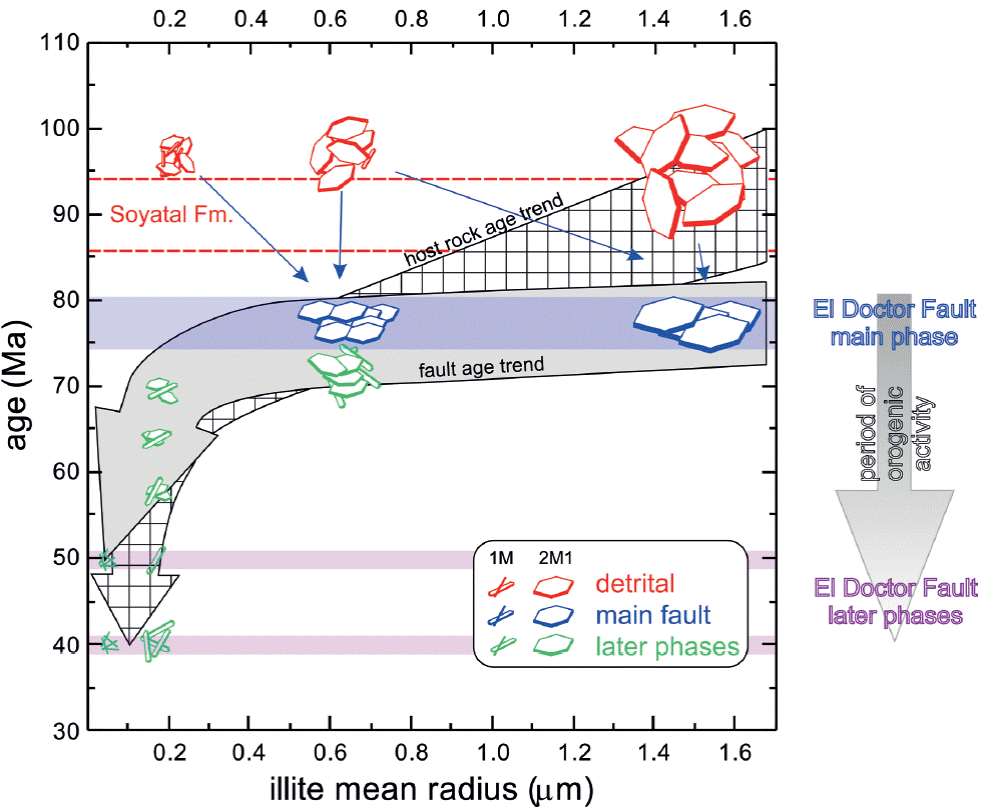
Figure 10 Conceptual model for the interpretation of K-Ar age versus grain size patterns obtained in this work. Two trends are observed: (a) ages from the fault zone, and (b) ages from the host rock (Soyatal Formation). The coarse fractions from the fault zone date the earliest and most important tectonic event at the El Doctor fault (blue color). The finest size fraction from the fault zone dates the timing of the last fault reactivation (green color). The host rock age trend presents an inherited (detrital, red color) age for the very coarse fractions which intersect the fault age trend at the coarse fractions and decrease to lower ages in the finest fractions. This trend is indicative of a detrital component which is partially reset during the formation of the tectonic wedge and contains very small neoformed illites due to the last tectonic movements and diagenesis.
The tectonic wedge model
In our opinion the general interpretation clue is the tectonic model of the orogenic wedge. Analog and numerical models (e.g., Stockmal et al., 2007; Buiter, 2012; Jamieson and Beaumont, 2013) show that during wedge progression, creation and displacement of thrusts begins near the region of initial stress (i.e., the region where the 'bulldozer' pushes the wedge) and translates to the foreland. The progression is visible by the propagation of deformation in that direction. The oldest deformation will be located near the 'bulldozer', and the youngest deformation will be on the opposite side. In the case of the MFTB, the oldest deformation must be in the West and the youngest deformation is in the East, as discussed in a previous section. This age progression has been found by indirect dating in a W-E section across Central Mexico by Cuéllar-Cárdenas et al. (2012). Nevertheless, all analog and numerical models (op. cit.) show that during the progression of the wedge, the oldest part ('fossilized' following the simplistic models) is in fact reworked several times taking advantage of the weaker zones, i.e., previous faults and thrusts. This translates to the classical observation of faults which show various episodes of movement.
Dating of clays associated with such faults cannot give a single age, unless the fault has remained at high temperature and pressure (probably no longer a fault but a shear zone). In the normal case of anchizone-low epizone faults and thrusts, clays must provide a range of ages, indicating episodes of clay growth related to fault movement and associated fluid circulation.
The Laramide orogeny
The Laramide orogeny is the credited cause for the development of the main Late Mesozoic-Early Cenozoic structures of Central Mexico (e.g. Cuéllar-Cárdenas et al., 2012), including the El Doctor fault. We do not wish to discuss this attribute, but we do wish to mention four points. Firstly, the Laramide orogeny is not much older than ~75 Ma (e.g., Bird, 2002), as defined in the original outcrops from the USA. Secondly, older deformation starting at ~120 Ma is defined as the Sevier orogeny (e.g., Heller and Paola, 1989). Thirdly, it is not clear that both orogenies, defined in the USA, can be extrapolated to Mexico in both cause and timing. Finally, de Cserna (1960) and Guzmán and de Cserna (1963) defined the Hidalgoan orogeny in Eastern Mexico as being simultaneous with the Sevier orogeny and spanning as late as ~52 Ma overlapping with the Laramide orogeny.
Following this unclear scenario, the best we can do is to name the Mexican orogeny as Laramide sensu lato, to be consistent with the many publications about Mexican tectonics, and to make clear that any attribution to one or another orogenic name defined in the USA is, at least, uncertain. Our interpretation suggests that most of the history of the MFTB is recorded in a single regional scale thrust which undergoes repeated reactivations during development of the orogen.
CONCLUSIONS
The El Doctor fault is an important structure located in the MFTB that superposes the slight deformed rocks of the El Doctor Formation (Albian-Cenomanian period) over tubiditic synsedimentary rocks from the Soyatal Formation (Turonian-Coniacian period). The fault core displays a high anchizone-low epizone texture and mineralogy.
The occurrence of neoformed illite-mica layers oriented along the fabric of the fault core and suggests a process of dissolution and recrystallization of this mineral. Based on available data and closure temperature calculations we can infer that its age records the time elapsed since authigenic mineral growth within the fault zone, because during recrystallization radiogenic argon was lost from the <2 μm crystals.
Different faulting episodes were accommodated by the El Doctor fault and the K-Ar ages define a time range during which the fault was active. K-Ar data from illite-mica support a model in which the El Doctor thrust formation occurred at 80-75 Ma. This age is obtained from the coarse clay fractions (2-0.5 μm), which are younger than the age of sedimentation of the Soyatal Formation. The youngest ages of 50 and 40 Ma indicate 1M illite formation by later events related to fault movement plus diagenesis.
The significance of intermediate ages which decrease with grain size cannot be deciphered with the available data, but can be interpreted considering a mixing between an authigenic illite-mica generation formed during the main fault phase and a younger authigenic lowtemperature illite. The correlation of fault movements to these ages cannot be ruled out.
The age of the El Doctor fault is in concordance with the term Laramide age sensu lato defined above, i.e. a deformation active between the Cenomanian and Eocene periods (e.g., Schmidt and Perry, 1988; Gray et al., 2001). The K-Ar ages of illite suggest that, in this part of the Mexican Fold and Thrust Belt, deformation remains active during the whole development of the orogenic wedge.











 nueva página del texto (beta)
nueva página del texto (beta)

